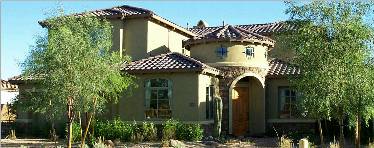|
Remember the Jetsons? Believe
it or not, each day we are moving closer and closer to the
automated world portrayed in the cartoon. Look at today's
newer homes, built with a structured wiring system providing
lightning fast internet and High Definition television.
Think back 5 - 10 years ago, we had no idea that such possibilities
existed. It is important to understand what value the
structured wiring systems bring to today's buyers.
Most buyers of today
will have at least one computer within their home. Many
will have two. The term SOHO Small Office Home Office
is in full swing in Arizona. Each day, more and more
people are opting to work from home than ever before.
With this, the expectactions of having their homes technologically
capable are greater. They seek high-speed connections
with the ability to have mulitple computers on the net simultaneously.
To take it further they are seeking expandability such as
WiFi (wireless network), which allows today's computer users
to search the web without wires, perhaps from their laptop
on the patio beside the pool.
All this flexibility
is bound by the amount of data and the speed that it can be
transmitted within the home network. A structured wiring
system is essentially a network allowing the fast transmission
of large amounts of data throughout the home and ultimately
too and from the web. The following are some key terms
used when home networks and structured wiring are discussed.
Network
- The means by which computers and other networking devices
are connected together so that print services, files, equipment,
and software applications may be shared.
Local area
network (LAN) - Technologies connect many devices
that are relatively close to each other, usually in the same
building.
Wide area
network (WAN) - Technologies connect a smaller number
of devices that can be many miles apart.
WiFi
- Wireless networking. Utilizing radio signals and tiny antennas,
computers can be networked within a 100' area of one another.
Bandwidth
- Describes the rate at which a network can transfer data.
Standard Ethernet operates at 10Mbps. Fast Ethernet
operates at 100Mbps.
Twisted-Pair
Cable - A cable used for both network communications
and telephone communications. Also known as UTP (unshielded
twisted pair) and 10BASE-T/100BASE-T cable.
Category
5 Cabling - A higher grade of unshielded twisted-pair
cabling required for networking applications such as 100Mbps
Fast Ethernet. Most commonly pre-wired in buildings
wired within the last five years.
Coaxial
Cable - A cable composed of an insulated central
conducting wire wrapped in another cylindrical conductor (the
shield). The whole thing is usually wrapped in another
insulating layer and an outer protective layer. A coaxial
cable has great capacity to carry vast quantities of information.
It is typically used in high-speed data and CATV applications.
Fiber-Optic
Cable - Fiber-optic cables transmit digital signals
as light pulses. Fiber optic cable connections are made through
an AUI port using an external transceiver.
RJ-11
- A standard telephone modular connector.
RJ-45 jack - The connector on the back of a
computer or printer that accepts the RJ-45 plug; looks much
like a modular telephone jack.
RJ-45 plug
- The connector on the end of 10BASE-T or 100BASE-T twisted-pair
cabling; looks much like a modular telephone plug.
Routers
- Advanced networking components that can divide
a single network into two logically separate networks. While
Ethernet broadcasts cross bridges in their search to find
every node on the network, they do not cross routers
because the router forms a logical boundary for the network.
Hub - Also
referred to as a "repeater" or "concentrator", its primary
function is to receive and send signals along the network
between the nodes connected to it. For home users, hubs
usually have 4-8 "ports" (or RJ-45 jacks) that connect cables
coming from individual computers on the network.
Structured
Wiring - A "home-run" wiring strategy and a minimum
set of wires. With home-run wiring you make all
the wiring runs from a central point in the house, usually
in a closet. At the central point, the wires terminate
at various types of patch panels that let you connect to equipment
such as signal amplifiers or network hubs and to external
sources such as the incoming telephone and cable TV lines.
Additional
Resources:
cabletesting.com
www.cabletesting.com
Cox Communicatons
www.cox.net
Leviton Voice and
Data Learning Center www.levitonvoicedata.com/learning/default.asp
Smart Home www.smarthome.com
Qwest www.qwest.com
|



